Unit 1 How tall are you? 单元教案(6个课时)
文档属性
| 名称 | Unit 1 How tall are you? 单元教案(6个课时) | 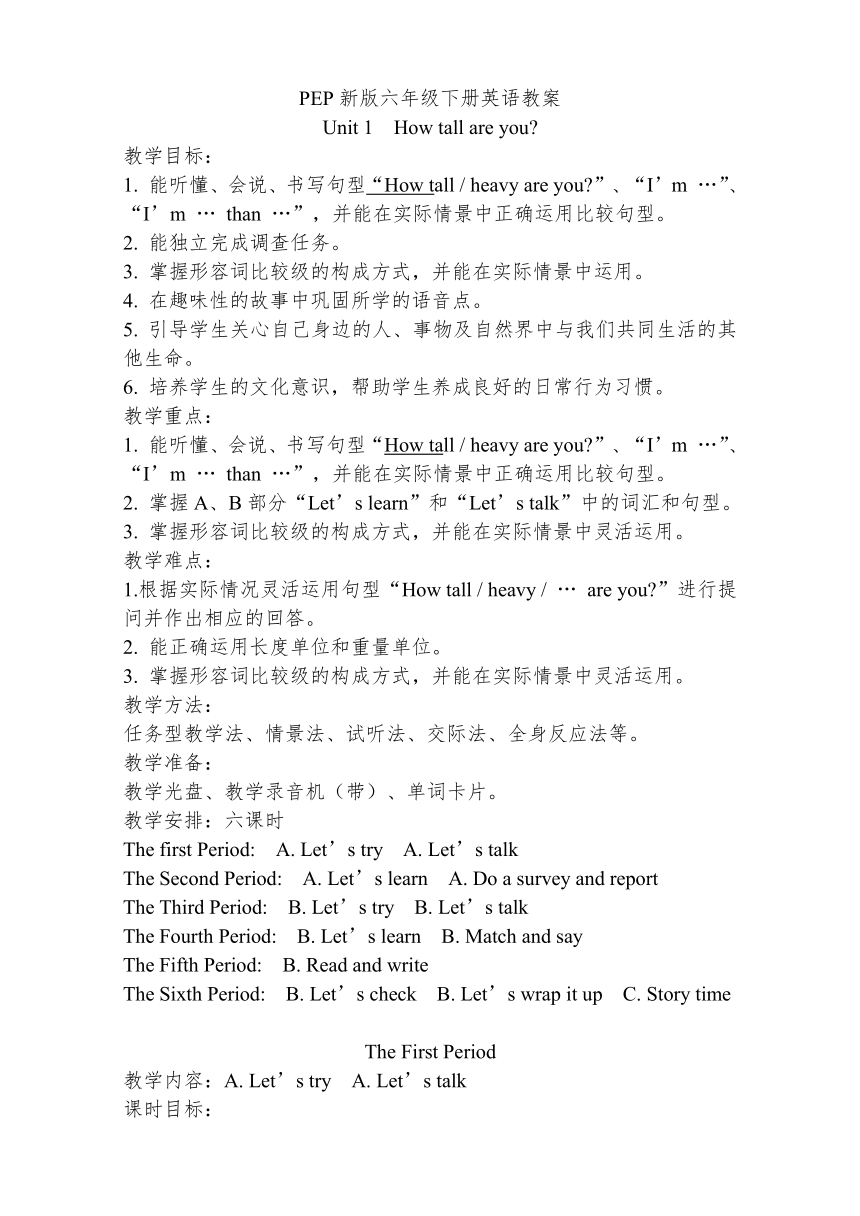 | |
| 格式 | zip | ||
| 文件大小 | 30.8KB | ||
| 资源类型 | 教案 | ||
| 版本资源 | 人教版(PEP) | ||
| 科目 | 英语 | ||
| 更新时间 | 2016-11-19 15:04:30 | ||
图片预览

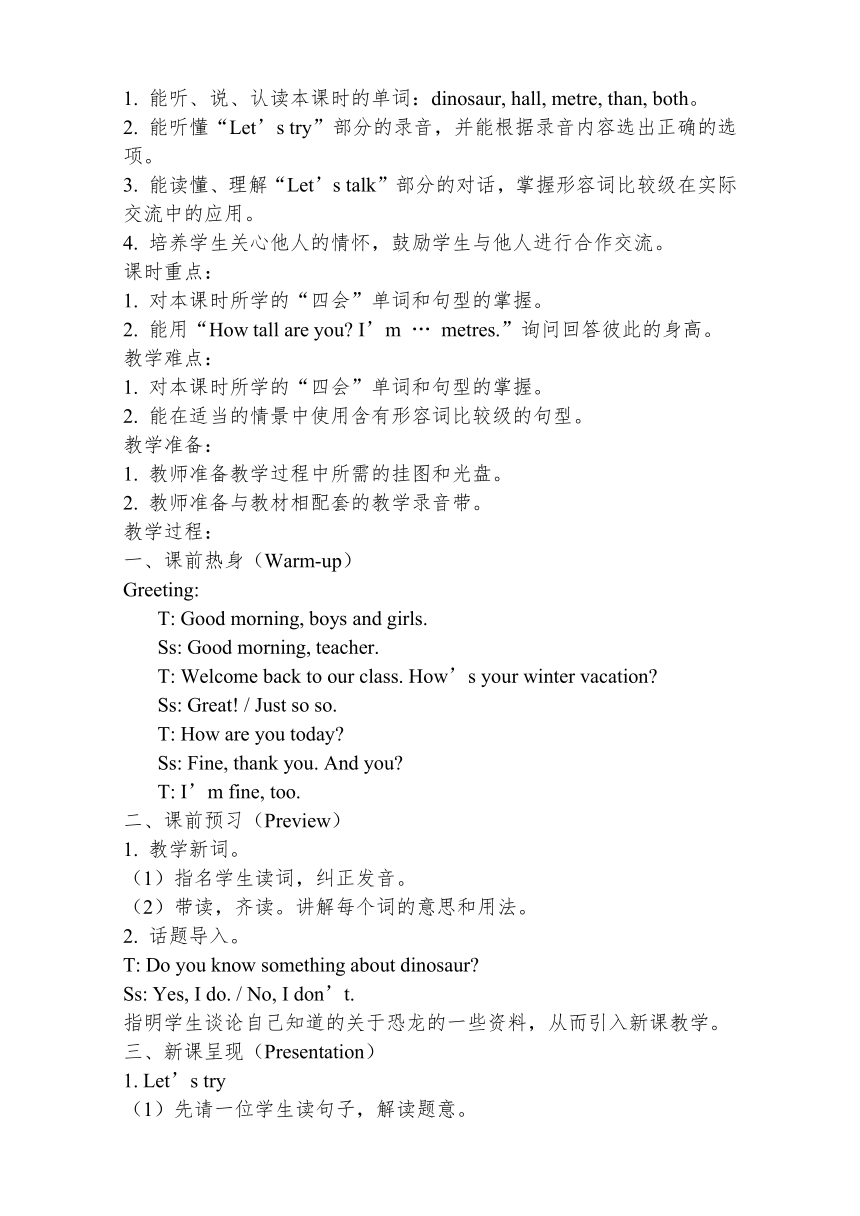
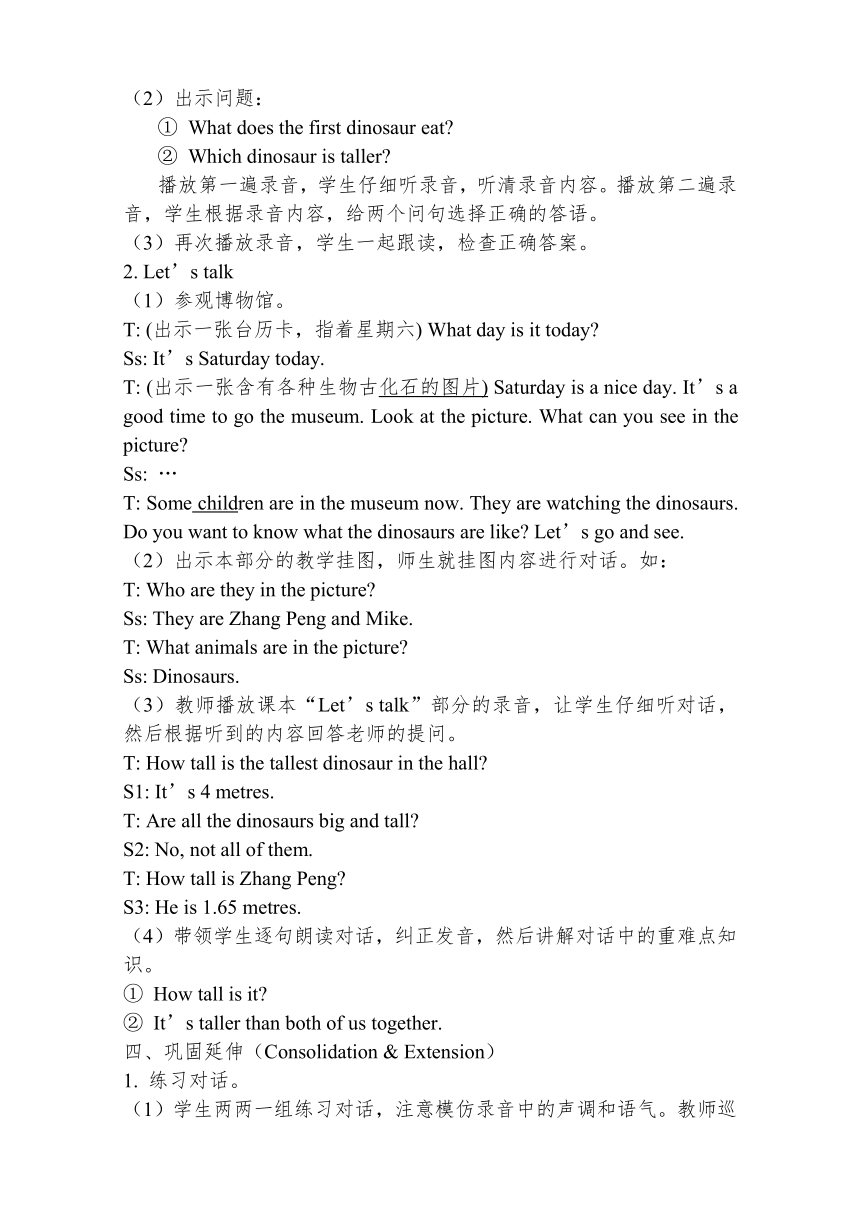
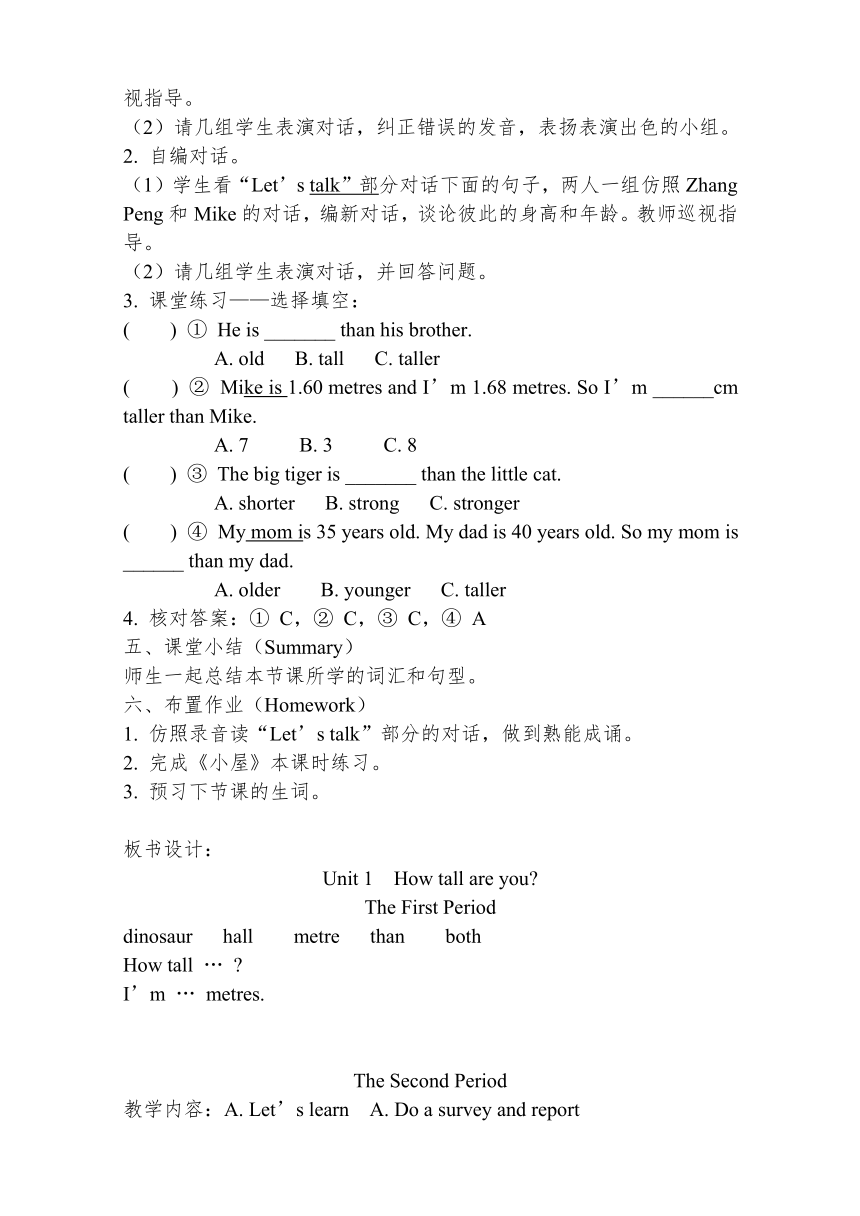
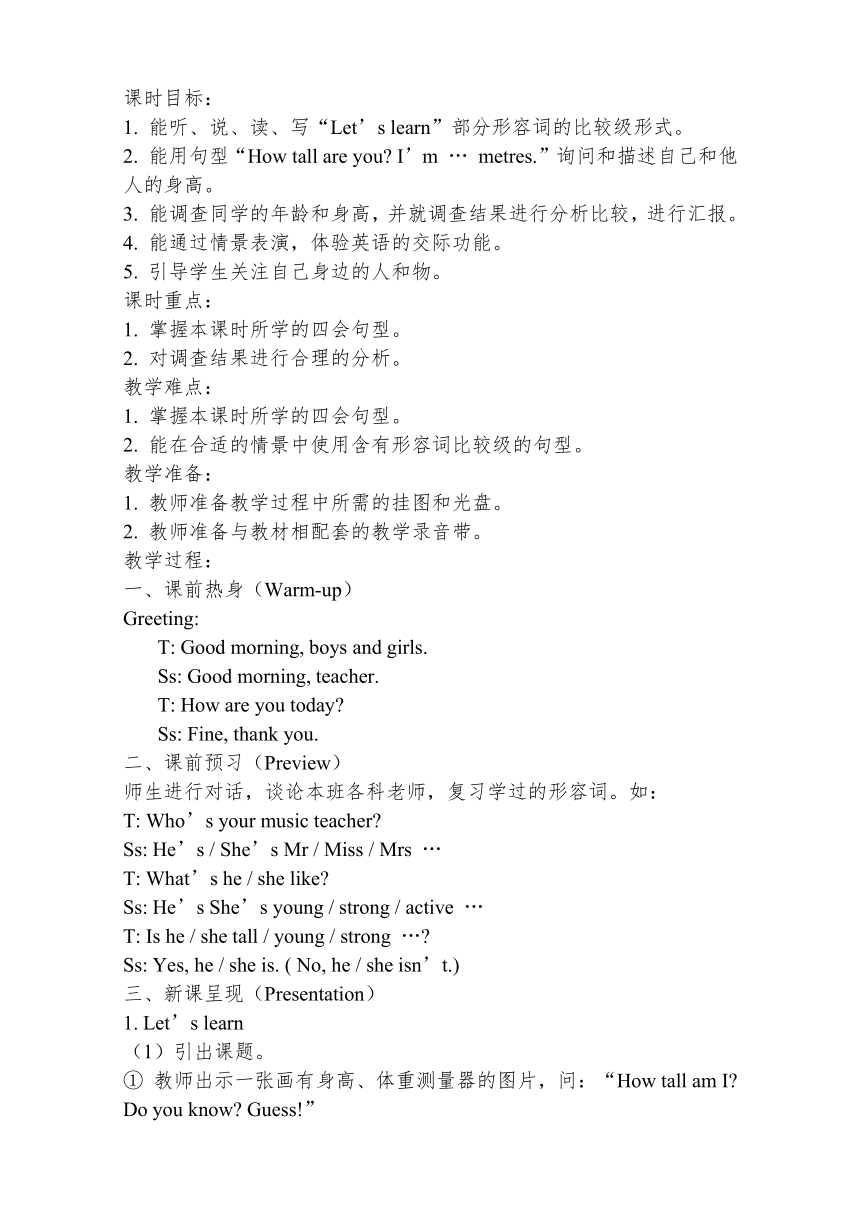
文档简介
PEP新版六年级下册英语教案
Unit
1
How
tall
are
you
教学目标:
1.
能听懂、会说、书写句型“How
t
( http: / / www.21cnjy.com )all
/
heavy
are
you ”、“I’m
…”、“I’m
…
than
…”,并能在实际情景中正确运用比较句型。
2.
能独立完成调查任务。
3.
掌握形容词比较级的构成方式,并能在实际情景中运用。
4.
在趣味性的故事中巩固所学的语音点。
5.
引导学生关心自己身边的人、事物及自然界中与我们共同生活的其他生命。
6.
培养学生的文化意识,帮助学生养成良好的日常行为习惯。
教学重点:
1.
能听懂、会说、书写句型“How
ta
( http: / / www.21cnjy.com )ll
/
heavy
are
you ”、“I’m
…”、“I’m
…
than
…”,并能在实际情景中正确运用比较句型。
2.
掌握A、B部分“Let’s
learn”和“Let’s
talk”中的词汇和句型。
3.
掌握形容词比较级的构成方式,并能在实际情景中灵活运用。
教学难点:
1.根据实际情况灵活运用句型“How
tall
/
heavy
/
…
are
you ”进行提问并作出相应的回答。
2.
能正确运用长度单位和重量单位。
3.
掌握形容词比较级的构成方式,并能在实际情景中灵活运用。
教学方法:
任务型教学法、情景法、试听法、交际法、全身反应法等。
教学准备:
教学光盘、教学录音机(带)、单词卡片。
教学安排:六课时
The
first
Period:
A.
Let’s
try
A.
Let’s
talk
The
Second
Period:
A.
Let’s
learn
A.
Do
a
survey
and
report
The
Third
Period:
B.
Let’s
try
B.
Let’s
talk
The
Fourth
Period:
B.
Let’s
learn
B.
Match
and
say
The
Fifth
Period:
B.
Read
and
write
The
Sixth
Period:
B.
Let’s
check
B.
Let’s
wrap
it
up
C.
Story
time
The
First
Period
教学内容:A.
Let’s
try
A.
Let’s
talk
课时目标:
1.
能听、说、认读本课时的单词:dinosaur,
hall,
metre,
than,
both。
2.
能听懂“Let’s
try”部分的录音,并能根据录音内容选出正确的选项。
3.
能读懂、理解“Let’s
talk”部分的对话,掌握形容词比较级在实际交流中的应用。
4.
培养学生关心他人的情怀,鼓励学生与他人进行合作交流。
课时重点:
1.
对本课时所学的“四会”单词和句型的掌握。
2.
能用“How
tall
are
you
I’m
…
metres.”询问回答彼此的身高。
教学难点:
1.
对本课时所学的“四会”单词和句型的掌握。
2.
能在适当的情景中使用含有形容词比较级的句型。
教学准备:
1.
教师准备教学过程中所需的挂图和光盘。
2.
教师准备与教材相配套的教学录音带。
教学过程:
一、课前热身(Warm-up)
Greeting:
T:
Good
morning,
boys
and
girls.
Ss:
Good
morning,
teacher.
T:
Welcome
back
to
our
class.
How’s
your
winter
vacation
Ss:
Great!
/
Just
so
so.
T:
How
are
you
today
Ss:
Fine,
thank
you.
And
you
T:
I’m
fine,
too.
二、课前预习(Preview)
1.
教学新词。
(1)指名学生读词,纠正发音。
(2)带读,齐读。讲解每个词的意思和用法。
2.
话题导入。
T:
Do
you
know
something
about
dinosaur
Ss:
Yes,
I
do.
/
No,
I
don’t.
指明学生谈论自己知道的关于恐龙的一些资料,从而引入新课教学。
三、新课呈现(Presentation)
1.
Let’s
try
(1)先请一位学生读句子,解读题意。
(2)出示问题:
①
What
does
the
first
dinosaur
eat
②
Which
dinosaur
is
taller
播放第一遍录音,学生仔细听录音,听清录音内容。播放第二遍录音,学生根据录音内容,给两个问句选择正确的答语。
(3)再次播放录音,学生一起跟读,检查正确答案。
2.
Let’s
talk
(1)参观博物馆。
T:
(出示一张台历卡,指着星期六)
What
day
is
it
today
Ss:
It’s
Saturday
today.
T:
(出示一张含有各种生物古化石的图片)
( http: / / www.21cnjy.com )
Saturday
is
a
nice
day.
It’s
a
good
time
to
go
the
museum.
Look
at
the
picture.
What
can
you
see
in
the
picture
Ss:
…
T:
Some
child
( http: / / www.21cnjy.com )ren
are
in
the
museum
now.
They
are
watching
the
dinosaurs.
Do
you
want
to
know
what
the
dinosaurs
are
like
Let’s
go
and
see.
(2)出示本部分的教学挂图,师生就挂图内容进行对话。如:
T:
Who
are
they
in
the
picture
Ss:
They
are
Zhang
Peng
and
Mike.
T:
What
animals
are
in
the
picture
Ss:
Dinosaurs.
(3)教师播放课本“Let’s
talk”部分的录音,让学生仔细听对话,然后根据听到的内容回答老师的提问。
T:
How
tall
is
the
tallest
dinosaur
in
the
hall
S1:
It’s
4
metres.
T:
Are
all
the
dinosaurs
big
and
tall
S2:
No,
not
all
of
them.
T:
How
tall
is
Zhang
Peng
S3:
He
is
1.65
metres.
(4)带领学生逐句朗读对话,纠正发音,然后讲解对话中的重难点知识。
①
How
tall
is
it
②
It’s
taller
than
both
of
us
together.
四、巩固延伸(Consolidation
&
Extension)
1.
练习对话。
(1)学生两两一组练习对话,注意模仿录音中的声调和语气。教师巡视指导。
(2)请几组学生表演对话,纠正错误的发音,表扬表演出色的小组。
2.
自编对话。
(1)学生看“Let’s
talk”部
( http: / / www.21cnjy.com )分对话下面的句子,两人一组仿照Zhang
Peng和Mike的对话,编新对话,谈论彼此的身高和年龄。教师巡视指导。
(2)请几组学生表演对话,并回答问题。
3.
课堂练习——选择填空:
(
)
①
He
is
_______
than
his
brother.
A.
old
B.
tall
C.
taller
(
)
②
Mike
is
( http: / / www.21cnjy.com )1.60
metres
and
I’m
1.68
metres.
So
I’m
______cm
taller
than
Mike.
A.
7
B.
3
C.
8
(
)
③
The
big
tiger
is
_______
than
the
little
cat.
A.
shorter
B.
strong
C.
stronger
(
)
④
My
mom
i
( http: / / www.21cnjy.com )s
35
years
old.
My
dad
is
40
years
old.
So
my
mom
is
______
than
my
dad.
A.
older
B.
younger
C.
taller
4.
核对答案:①
C,②
C,③
C,④
A
五、课堂小结(Summary)
师生一起总结本节课所学的词汇和句型。
六、布置作业(Homework)
1.
仿照录音读“Let’s
talk”部分的对话,做到熟能成诵。
2.
完成《小屋》本课时练习。
3.
预习下节课的生词。
板书设计:
Unit
1
How
tall
are
you
The
First
Period
dinosaur
hall
metre
than
both
How
tall
…
I’m
…
metres.
The
Second
Period
教学内容:A.
Let’s
learn
A.
Do
a
survey
and
report
课时目标:
1.
能听、说、读、写“Let’s
learn”部分形容词的比较级形式。
2.
能用句型“How
tall
are
you
I’m
…
metres.”询问和描述自己和他人的身高。
3.
能调查同学的年龄和身高,并就调查结果进行分析比较,进行汇报。
4.
能通过情景表演,体验英语的交际功能。
5.
引导学生关注自己身边的人和物。
课时重点:
1.
掌握本课时所学的四会句型。
2.
对调查结果进行合理的分析。
教学难点:
1.
掌握本课时所学的四会句型。
2.
能在合适的情景中使用含有形容词比较级的句型。
教学准备:
1.
教师准备教学过程中所需的挂图和光盘。
2.
教师准备与教材相配套的教学录音带。
教学过程:
一、课前热身(Warm-up)
Greeting:
T:
Good
morning,
boys
and
girls.
Ss:
Good
morning,
teacher.
T:
How
are
you
today
Ss:
Fine,
thank
you.
二、课前预习(Preview)
师生进行对话,谈论本班各科老师,复习学过的形容词。如:
T:
Who’s
your
music
teacher
Ss:
He’s
/
She’s
Mr
/
Miss
/
Mrs
…
T:
What’s
he
/
she
like
Ss:
He’s
She’s
young
/
strong
/
active
…
T:
Is
he
/
she
tall
/
young
/
strong
…
Ss:
Yes,
he
/
she
is.
(
No,
he
/
she
isn’t.)
三、新课呈现(Presentation)
1.
Let’s
learn
(1)引出课题。
①
教师出示一张画有身高、体重测量器的图片,问:“How
tall
am
I
Do
you
know
Guess!”
②
教师可以用“up
and
down”的方式帮助学生猜出准确的数字。
③
教师让猜中自己准确身高的学生站起来,问:
( http: / / www.21cnjy.com )“How
tall
are
you ”并拿出卷尺帮助他/她测量身高,然后教师说:“He
/
She
is
taller
than
me.”或“I’m
taller
than
him
/
her.”
④
板书课题:How
tall
are
you
(2)教学新词汇。
①
教师在黑板上画出下面的表格,并调查几位学生的身高。
Name
Height
教师用句型,如“A
is
( http: / / www.21cnjy.com )…
metres.
B
is
taller
than
A.
C
is
taller
than
B.
D
is
taller
than
C.
C
is
shorter
than
D.
B
is
shorter
than
C.”谈论表格中学生的身高。
板书单词:tall,
taller,
short,
shorter,并带学生读几遍。
②
教师拿出一把短尺子和
( http: / / www.21cnjy.com )一把长尺子,说:“This
is
a
short
ruler.
It
is
shorter.
This
is
a
long
ruler.
It
is
longer.
板书单词:shorter,
longer
③
教师在黑板上列出自己家人的年龄,说
( http: / / www.21cnjy.com ):“My
mother
is
54.
My
father
is
56.
My
father
is
older
than
my
mother.
My
aunt
is
younger
than
my
father,
but
she
is
older
than
my
mother.
How
old
is
she
板书单词:old,
older;
young,
younger。带学生读几遍。
(3)师生用“唱反调”的方法练习读新单词。
规则:教师大声读单词,学生小声读单词;教师小声读单词,学生就大声读单词。
(4)播放两遍“Let’s
learn”部分的录音,学生跟录音读。
(5)学生同桌之间用句型“How
ta
( http: / / www.21cnjy.com )ll
/
old
are
you ”和“I’m
…
metres
/
years
old.
I’m
taller
/
shorter
/
older
/
younger
than
you.”谈论彼此的身高和年龄。
(6)学生同桌之间分角色练习读本部分的词汇和对话。
(7)讲解本部分的重难点知识。
①
How
tall
are
you
②
I’m
1.61metres.
③
You’re
older
than
me,
too.
④
形容词比较级形式的构成规则。
2.
Do
a
survey
and
report.
(1)教师出示下列表格,让学生在六人小组内调查。
Name
Age
Height
(2)请一对学生失分读表格旁边的对话。
(3)学生在小组内汇报自己的调查结果,然后教师请几位小组代表进行汇报。
四、巩固延伸(Consolidation
&
Extension)
1.
Play
game:
Lin
( http: / / www.21cnjy.com )e
up
from
taller
to
shorter.
/
Line
up
from
shorter
to
taller.
2.
课堂练习——用所学的表示比较的句型写几句话,介绍自己的家庭成员。
3.
反馈:把学生分成四人小组,学生先在小组内用所学的句型介绍比较自己的家庭成员,然后教师请几位小组代表进行汇报。
五、课堂小结(Summary)
师生一起总结本节课所学的词汇和句型。
六、布置作业(Homework)
1.
仿照录音读“Let’s
learn”部分的对话,提醒学生仿照录音中的语音、语调。
2.
在四线三格上抄写五遍本节课所学的四会词语。
3.
完成《小屋》本课时练习。
4.
预习下节课的生词。
板书设计:
Unit
1
How
tall
are
you
The
Second
Period
younger
----
older
shorter
----
taller
shorter
----
longer
How
tall
are
you
I’m
…
metres.
You’re
older
than
me,
too.
The
Third
Period
教学内容:B.
Let’s
try
B.
Let’s
talk
课时目标:
1.
能完成“Let’s
try”部分的听录音选选项的练习。
2.
能读懂、理解“Let’s
talk”部分的对话,并能在实际交流中的应用。
3.
能听懂、会书写句型“What
si
( http: / / www.21cnjy.com )ze
are
your
shoes
Size
…”、“How
heavy
are
you
I’m
…
kilograms.”并能在实际情景中准确运用。
课时重点:
能询问、回答有关身高、体重、脚的大小尺寸等问题,并能书写相关句型。
教学难点:
能听懂、会书写句型“What
siz
( http: / / www.21cnjy.com )e
are
your
shoes
Size
…”、“How
heavy
are
you
I’m
…
kilograms.”并能在实际情景中准确运用。
教学准备:
1.
教师准备教学过程中所需的挂图和光盘。
2.
教师准备与教材相配套的教学录音带。
教学过程:
一、课前热身(Warm-up)
Greeting:
T:
Good
morning,
boys
and
girls.
Ss:
Good
morning,
teacher.
T:
How
are
you
today
Ss:
Fine,
thank
you.
二、课前预习(Preview)
1.
句子接龙:
把学生分成四大组,学生在小组内进行“句
( http: / / www.21cnjy.com )子接龙”游戏,第一个学生用所学的比较句型说一个句子,第二个学生重复上一个学生所说的句子,并自己在说一个句子,以此类推。
2.
量一量:
让学生拿出直尺,量一量自己的书本、文具盒、课桌、板凳等物体的长度,然后同桌之间进行对话,如:
S1:
How
long
is
your
book
S2:
It’s
…cm
long.
S1:
How
long
is
your
pencil
box
S2:
It’s
…cm
long.
…
三、新课呈现(Presentation)
1.
Let’s
try
(1)先请一位学生读句子,解读题意。
(2)出示问题:
①
What
do
Wu
Yifan
and
Mike
want
to
do
first
②
What
are
they
going
to
buy
播放第一遍录音,学生仔细听录音,听清录音内容。播放第二遍录音,学生根据录音内容,选出合适的选项。
(3)再次播放录音,学生一起跟读,检查正确答案。
2.
Let’s
talk
(1)教师出示几张名人的照片,并在照片下面附上人物相应的基本资料。师生就人物照片二号所给的基本资料进行对话,如:
T:
How
tall
is
…
Ss:
He’s
/
She’s
…
cm
tall.
T:
How
heavy
is
…
Ss:
He’s
/
She’s
…
kg.
…
(2)猜体重。
师生就各自的体重进行对话,如:
T:
I’m
a
little
heavy
/
light.
Can
you
guess
how
heavy
I
am
Ss:
60
kg.
T:
No,
a
little
heavier
/
lighter.
当学生猜对时,教师说:“Yes,
you
are
right.”
(3)教师播放课本“Let’s
talk”部分的录音,让学生仔细听对话,然后根据听到的内容回答老师的提问。
①
How
heavy
is
Wu
Yifan
②
Who’s
taller
③
How
big
are
Mike’s
feet
Answer:
①
He’s
46
kilgrams.
②
Wu
Yifan
is
taller.
③
He
wears
size
8.
(4)再次播放教学录音,全班学生分男女生跟录音朗读对话,提醒学生注意模仿录音中的语音、语调。
(5)让学生同桌之间分角色表演对话,然后请几对学生上讲台进行表演。
(6)讲解重难点知识。
①
How
heavy
are
you
②
What
size
are
your
shoes,
Mike
③
In
China
I
wear
size
38
shoes.
四、巩固延伸(Consolidation
&
Extension)
1.
Pair
work
(1)学生同桌之间相互调查彼此的身高、体重、鞋码,并做记录。
(2)请两位学生示范读对话,
(3)教师引导学生分析比较调查结果并进行汇报。
2.
课堂练习——选词填空:
A.
big
B.
long
C.
heavy
D.
old
E.
tall
(
)
①
-
How
______
are
you
-
I’m
12.
(
)
②
-
How
______
are
you
-
I’m
60
kg.
(
)
③
-
How
______
is
your
pencil
-
It’s
10
cm.
(
)
④
-
How
______
is
your
sister
-
She’s
155
cm.
(
)
⑤
-
How
______
are
your
feet
-
I
wear
size
17.
4.
核对答案:①
D,②
C,③
B,④
E,⑤
A
五、课堂小结(Summary)
师生一起总结本节课所学的词汇和句型。
六、布置作业(Homework)
1.
仿照录音读“Let’s
talk”部分的对话,并尝试背诵。
2.
完成《小屋》本课时练习。
3.
对自己家庭成员的体重、身高、头发的长度以及所穿鞋子的尺码进行调查,并填写调查报告。
Mother
Father
Brother
Sister
Weight
Height
Hair
Feet
4.
预习下节课的生词。
板书设计:
Unit
1
How
tall
are
you
The
Third
Period
What
size
are
your
shoes,
Mike
Size
8.
In
China
I
wear
size
38
shoes.
How
heavy
are
you
I’m
48
kilograms.
The
Fourth
Period
教学内容:B.
Let’s
learn
B.
Match
and
say
课时目标:
1.
能听、说、读、写形容词的比较级形式:heavier,
thinner,
bigger,
smaller,
stronger。
2.
能灵活运用所学的形容词比较级描述人物或动物的特征差异。
3.
培养学生对身边的人和物的兴趣。
课时重点:
1.
能听、说、读、写形容词的比较级形式:heavier,
thinner,
bigger,
smaller,
stronger。
2.
能灵活运用所学的形容词比较级描述人物或动物的特征差异。
教学难点:
单词“heavy”、“thin”和“big”的比较级的构成方式。
教学准备:
1.
教师准备教学过程中所需的挂图和光盘。
2.
教师准备与教材相配套的教学录音带。
教学过程:
一、课前热身(Warm-up)
1.
Greeting:
T:
Hello,
boys
and
girls.
How
are
you
today
Ss:
Fine,
thank
you.
And
you
T:
I’m
fine,
too.
Nice
to
see
you
again.
Ss:
Nice
to
see
you,
too.
2.
Sing
a
song.
(1)播放两遍本单元的歌曲“My
small
cat”录音,学生仔细听录音,并小声跟录音唱歌曲。
(2)再次播放歌曲录音,全班学生大声跟录音唱歌曲。
二、课前预习(Preview)
1.
检查作业。
(1)先让学生在四人小组内展示自己家庭成员的调查表,并适当讲解表格里的内容。
(2)请几位学生介绍自己的家庭成员。
2.
游戏:句子接龙。
三、新课呈现(Presentation)
1.
Let’s
learn.
(1)教学新词汇。
①
教师拿出一个气球,边说:“
( http: / / www.21cnjy.com )Please
make
it
big.”边吹气球。教师接着说:“Make
it
bigger.”边说边把气球吹得更大些,然后教师边说“Make
it
smaller.”边把气球中的气放出来一些,使气球变小。
板书单词:bigger----smaller
②
教师拿出一个相对较小的铅球,说:“
( http: / / www.21cnjy.com )This
ball
is
heavy.”接着拿起一个大一些的铅球,做出很吃力的样子,说:“This
ball
is
heavier.”
板书单词:heavier
③
教师问:“Who
is
thin
in
( http: / / www.21cnjy.com )
our
class ”学生说出几个人名后教师接着问:“Who’s
thinner ”学生回答后,教师说:“…
is
thinner.”
板书单词:thinner
(2)播放本部分的教学录音,学生跟录音读单词和句子,提醒学生注意模仿录音总的语音、语调。
(3)教师出示几张动物的图片,让学生在四人小组内用表示比较级的句型谈论图片中的动物。
2.
Match
and
say.
(1)教师出示此部分的教学挂
( http: / / www.21cnjy.com )图,问:“Who
are
in
the
picture
What
animals
are
in
the
picture ”
(2)学生回答后,教师请一位学生与自己分角色示范读对话。
(3)学生就此部分的挂图用所学的表示比较的句型进行对话,可以适当发挥。
四、巩固延伸(Consolidation
&
Extension)
1.
教师让学生同桌之间相互观察找不同点,然后分别用英语描述。如:
My
hair
is
longer.
My
nose
is
bigger.
I’m
thinner.
My
arms
are
longer.
I’m
taller.
My
hands
are
bigger.
I’m
heavier.
I’m
taller
and
thinner
than
you.
…
教师表扬描述得又快又对的学生。
2.
课堂练习——
①
It’s
_______
(cold)in
Harbin
than
in
Guangzhou.
②
Your
pencil
is
_________(short)than
Amy’s.
③
Mr
Zhang
is
______(thin)than
Mr
Zhao.
④
It’s______(hot)in
summer
than
in
fall.
⑤
Sarah’s
cake
is
________(big)than
Chen
Jie’s.
4.
核对答案:①
colder,②
shorter,③
thinner
,④
hotter,⑤
bigger
五、课堂小结(Summary)
师生一起总结本节课所学的词汇和句型。
六、布置作业(Homework)
1.
仿照录音读“Let’s
learn”部分的对话,做到熟能成诵。
2.
抄写五遍本节课所学的四会词语,并尝试用所学的句型写几句话。
3.
完成《小屋》本课时练习。
4.
预习下节课的生词。
板书设计:
Unit
1
How
tall
are
you
The
Fourth
Period
heavy----heavier
thin----thinner
big----bigger
How
heavy
are
you,
Jim
I’m
52
kilograms.
You’re
heavier
than
me.
The
Fifth
Period
教学内容:B.
Read
and
write
课时目标:
1.
能读懂“Read
and
write”部分的文章,完成后面的阅读练习。
2.
通过阅读活动,逐步培养学生的阅读技能。
3.
加强学生英语学习策略的培养,为学生的终身学习奠定基础。
课时重点:
让学生理解、会读“Let’s
read”部分的内容,培养学生的阅读能力。
教学难点:
培养学生的阅读能力。
教学准备:
1.
教师准备教学过程中所需的挂图和光盘。
2.
教师准备与教材相配套的教学录音带。
教学过程:
一、课前热身(Warm-up)
Greeting:
T:
Good
morning,
boys
and
girls.
Ss:
Good
morning,
teacher.
T:
How
are
you
today
Ss:
Fine,
thank
you.
T:
Welcome
back
to
class.
二、课前预习(Preview)
(1)四人小组讨论下面问题:
①
How
tall
are
you
②
How
heavy
are
you
③
Who’s
taller
than
you
④
Who’s
heavier
than
you
(2)请几位小组代表进行汇报。
三、新课呈现(Presentation)
Read
and
write.
(1)话题导入:
T:
How
many
seasons
in
a
year
Ss:
Four.
T:
What
are
they
Ss:
Spring,
summer,
autumn
and
winter
T:
Which
one
is
the
first
Ss:
Spring.
T:
Who
volunteer
to
( http: / / www.21cnjy.com )
tell
us
something
about
spring
Do
you
like
spring
Can
you
speak
out
some
changes
from
winter
to
spring
(2)分小组讨论交流,教师巡视。
(3)指名学生回答问题,说出春天的变化,提醒学生描述时用上形容词的比较级形式。
(4)课件出示课本上的两组图片,请学生说出每组图片的区别,勾选出属于春天的图片。
T:
Spring
is
very
b
( http: / / www.21cnjy.com )eautiful,
the
weather
is
always
fine.
So,
Wu
Yifan
and
his
family
are
going
on
a
trip
to
the
countryside.
He
tells
Robin
a
story.
What
is
it
Let’s
have
a
fast
reading.
(5)学生读故事,理解故事大意。
(6)指名学生复述故事内容。
(7)带领学生齐读短文,注意发音和语调。
(8)学生完成短文后面的选择题。
(9)学生两人一组补全对话,进行角色表演。
四、巩固延伸(Consolidation
&
Extension)
1.
课件出示问题:
①
Do
you
agree
with
Old
Tree
Why
②
Can
you
answer
Little
Duck’s
question
What’s
your
answer
③
Please
circle
the
( http: / / www.21cnjy.com )words
with
“-er”
Then
talk
about
the
changes
in
your
friends.
2.
让学生再次自读故事,分小组讨论问题的答案,教师巡视。然后,指名学生汇报答案,全班一起核对。
3.
课堂练习——选择填空:
(
)
①
This
dog’s
tail
is
long.
That
dog’s
tail
is
________.
A.
long
B.
longer
C.
heavier
(
)
②
-
How
tall
are
you,
Li
Qiang
-
__________
A.
I’m
74
kg.
B.
I
wear
size
43.
C.
I’m
158
cm.
(
)
③
-
How
_______
are
you
-
I’m
40kg.
A.
heavy
B.
tall
C.
big
(
)
④
-
________
monkey
is
stronger
-
The
brown
monkey
is
stronger.
A.
What
B.
Who
C.
Which
(
)
⑤
-
________
is
heavier
than
you
-
Tom
is
heavier
than
me.
A.
What
B.
Who
C.
Which
4.
核对答案:①
B,②
C,③
A,④
C,⑤
B
五、课堂小结(Summary)
师生一起总结本节课所学的词汇和句型。
六、布置作业(Homework)
1.
仿照录音读“Read
and
write”部分的对话,试着讲述给自己的爸爸妈妈听。
2.
完成《小屋》本课时练习。
3.
预习下节课的生词。
板书设计:
Unit
1
How
tall
are
you
The
Fifth
Period
countryside
lower
shadow
smarter
become
The
Sixth
Period
教学内容:B.
Let’s
check
B.
Let’s
wrap
it
up
C.
Story
time
课时目标:
1.
通过“Let’s
check”部分的听力练习,考查学生对本单元所学内容的掌握情况。
2.
能写出“Let’s
wrap
it
up”部分形容词的比较级形式,掌握不规则形式。
3.
能理解“Story
time”部分的趣味性故事。
4.
加强学生英语学习策略的培养,为学生的终身学习奠定基础。
课时重点:
1.
检测学生的学习成果。
2.
掌握形容词比较级的灵活运用。
教学难点:
掌握形容词比较级在实际情景中的应用。
教学准备:
1.
教师准备教学过程中所需的挂图和光盘。
2.
教师准备与教材相配套的教学录音带。
教学过程:
一、课前热身(Warm-up)
Free
talk:
T:
Good
morning,
boys
and
girls.
Ss:
Good
morning,
teacher.
T:
Welcome
back
to
our
class.
Glad
to
see
you
again.
Ss:
Glad
to
see
you,
too.
二、课前预习(Preview)
1.
教师说出一个形容词,学生说出与其相应的反义词。如:
big
----
small,
fa
( http: / / www.21cnjy.com )t
----
thin,
heavy
----
light,
long
----
short,
tall
----
short,
old
----
young
2.
教师与一位学生就彼此的身高进行对话,如:
T:
How
tall
are
you
Ss:
I’m
…
cm
tall.
T:
I’m
…
cm
tall.
I
( http: / / www.21cnjy.com )’m
...
cm
shorter
/
taller
than
you.
You’re
…
cm
taller
/
shorter
than
me.
三、新课呈现(Presentation)
1.
Let’s
check.
(1)让学生观察本部分的选项,然后播放教学录音,学生听完录音后圈出相应的图片。
(2)再次播放教学录音,师生一起核对答案。
2.
Let’s
wrap
it
up.
(1)课件出示此部分教学挂图,带领学生读词。
(2)指名学生总结归纳形容词比较级的规则和不规则变化形式。
(3)纠正可能存在的错误。
(4)让学生独自写出表格中每个形容词的比较级形式。
(5)请一名学生上台扮演。
(6)学生集体核对答案。
四、巩固延伸(Consolidation
&
Extension)
1.
Story
time.
(1)师生就足球的话题展开对话,如:
T:
(出示一张足球的图片)
Look
at
this
picture.
What’s
this
Ss:
It’s
a
football.
T:
Do
you
like
playing
football
Ss:
Yes,
I
do.
/
No,
I
don’t.
T:
(出示足球守门员的图片)
Look
( http: / / www.21cnjy.com )
at
the
man
in
the
picture.
He’s
a
goalkeeper.
A
goalkeeper
is
important
in
a
team.
A
good
goalkeeper
can
help
a
team
win
the
match.
(2)依次出示本部分的教学挂图,请学生仔细观察,猜测故事大意。
(3)教师简单讲述故事背景。
T:
An
animal
foot
( http: / / www.21cnjy.com )ball
team
wants
a
goalkeeper.
Zebra,
deer,
Giraffe
and
Dog
want
to
have
a
try.
(4)播放本部分的教学录音,让学生明白故事的大致内容。
(5)再次播放教学录音,让学生回答下面的问题:
①
How
tall
is
the
deer
②
Who
is
the
tallest
one
③
Why
can’t
Giraffe
be
the
goalkeeper
④
Who
is
an
excellent
goalkeeper
Answer:
①
He’s
1.8
metres.
②
Giraffe
is
the
tallest.
③
Because
his
neck
( http: / / www.21cnjy.com )
is
too
long.
The
others
can’t
reach
him.
Football
is
a
teamwork.
④
Hippo
is
an
excellent
goalkeeper.
(6)学生讲述从这个故事中自己懂得了什么道理。
2.
课堂练习——写出下列词的比较级形式:
①
big
___________
②
short
_____________
③
heavy
_________
④
fat
_______________
⑤
happy
_________
⑥
late
_______________
⑦
strong
_________
⑧
fine
______________
3.
核对答案:①
bigger,②
( http: / / www.21cnjy.com )shorter,③
heavier,④
fatter,⑤
happier,⑥
later,⑦
stronger,⑧
finer
五、课堂小结(Summary)
师生一起总结本单元所学的词汇和句型。
六、布置作业(Homework)
1.
模仿录音朗读“Story
time”部分的对话。
2.
熟记背诵本单元的四会词语和句子。
3.
完成《小屋》本课时练习。
4.
预习下个单元的新词。
板书设计:
Unit
1
How
tall
are
you
The
Sixth
Period
big
----
small
( http: / / www.21cnjy.com ),
fat
----
thin,
heavy
----
light,
long
----
short,
tall
----
short,
old
----
young
Unit
1
How
tall
are
you
教学目标:
1.
能听懂、会说、书写句型“How
t
( http: / / www.21cnjy.com )all
/
heavy
are
you ”、“I’m
…”、“I’m
…
than
…”,并能在实际情景中正确运用比较句型。
2.
能独立完成调查任务。
3.
掌握形容词比较级的构成方式,并能在实际情景中运用。
4.
在趣味性的故事中巩固所学的语音点。
5.
引导学生关心自己身边的人、事物及自然界中与我们共同生活的其他生命。
6.
培养学生的文化意识,帮助学生养成良好的日常行为习惯。
教学重点:
1.
能听懂、会说、书写句型“How
ta
( http: / / www.21cnjy.com )ll
/
heavy
are
you ”、“I’m
…”、“I’m
…
than
…”,并能在实际情景中正确运用比较句型。
2.
掌握A、B部分“Let’s
learn”和“Let’s
talk”中的词汇和句型。
3.
掌握形容词比较级的构成方式,并能在实际情景中灵活运用。
教学难点:
1.根据实际情况灵活运用句型“How
tall
/
heavy
/
…
are
you ”进行提问并作出相应的回答。
2.
能正确运用长度单位和重量单位。
3.
掌握形容词比较级的构成方式,并能在实际情景中灵活运用。
教学方法:
任务型教学法、情景法、试听法、交际法、全身反应法等。
教学准备:
教学光盘、教学录音机(带)、单词卡片。
教学安排:六课时
The
first
Period:
A.
Let’s
try
A.
Let’s
talk
The
Second
Period:
A.
Let’s
learn
A.
Do
a
survey
and
report
The
Third
Period:
B.
Let’s
try
B.
Let’s
talk
The
Fourth
Period:
B.
Let’s
learn
B.
Match
and
say
The
Fifth
Period:
B.
Read
and
write
The
Sixth
Period:
B.
Let’s
check
B.
Let’s
wrap
it
up
C.
Story
time
The
First
Period
教学内容:A.
Let’s
try
A.
Let’s
talk
课时目标:
1.
能听、说、认读本课时的单词:dinosaur,
hall,
metre,
than,
both。
2.
能听懂“Let’s
try”部分的录音,并能根据录音内容选出正确的选项。
3.
能读懂、理解“Let’s
talk”部分的对话,掌握形容词比较级在实际交流中的应用。
4.
培养学生关心他人的情怀,鼓励学生与他人进行合作交流。
课时重点:
1.
对本课时所学的“四会”单词和句型的掌握。
2.
能用“How
tall
are
you
I’m
…
metres.”询问回答彼此的身高。
教学难点:
1.
对本课时所学的“四会”单词和句型的掌握。
2.
能在适当的情景中使用含有形容词比较级的句型。
教学准备:
1.
教师准备教学过程中所需的挂图和光盘。
2.
教师准备与教材相配套的教学录音带。
教学过程:
一、课前热身(Warm-up)
Greeting:
T:
Good
morning,
boys
and
girls.
Ss:
Good
morning,
teacher.
T:
Welcome
back
to
our
class.
How’s
your
winter
vacation
Ss:
Great!
/
Just
so
so.
T:
How
are
you
today
Ss:
Fine,
thank
you.
And
you
T:
I’m
fine,
too.
二、课前预习(Preview)
1.
教学新词。
(1)指名学生读词,纠正发音。
(2)带读,齐读。讲解每个词的意思和用法。
2.
话题导入。
T:
Do
you
know
something
about
dinosaur
Ss:
Yes,
I
do.
/
No,
I
don’t.
指明学生谈论自己知道的关于恐龙的一些资料,从而引入新课教学。
三、新课呈现(Presentation)
1.
Let’s
try
(1)先请一位学生读句子,解读题意。
(2)出示问题:
①
What
does
the
first
dinosaur
eat
②
Which
dinosaur
is
taller
播放第一遍录音,学生仔细听录音,听清录音内容。播放第二遍录音,学生根据录音内容,给两个问句选择正确的答语。
(3)再次播放录音,学生一起跟读,检查正确答案。
2.
Let’s
talk
(1)参观博物馆。
T:
(出示一张台历卡,指着星期六)
What
day
is
it
today
Ss:
It’s
Saturday
today.
T:
(出示一张含有各种生物古化石的图片)
( http: / / www.21cnjy.com )
Saturday
is
a
nice
day.
It’s
a
good
time
to
go
the
museum.
Look
at
the
picture.
What
can
you
see
in
the
picture
Ss:
…
T:
Some
child
( http: / / www.21cnjy.com )ren
are
in
the
museum
now.
They
are
watching
the
dinosaurs.
Do
you
want
to
know
what
the
dinosaurs
are
like
Let’s
go
and
see.
(2)出示本部分的教学挂图,师生就挂图内容进行对话。如:
T:
Who
are
they
in
the
picture
Ss:
They
are
Zhang
Peng
and
Mike.
T:
What
animals
are
in
the
picture
Ss:
Dinosaurs.
(3)教师播放课本“Let’s
talk”部分的录音,让学生仔细听对话,然后根据听到的内容回答老师的提问。
T:
How
tall
is
the
tallest
dinosaur
in
the
hall
S1:
It’s
4
metres.
T:
Are
all
the
dinosaurs
big
and
tall
S2:
No,
not
all
of
them.
T:
How
tall
is
Zhang
Peng
S3:
He
is
1.65
metres.
(4)带领学生逐句朗读对话,纠正发音,然后讲解对话中的重难点知识。
①
How
tall
is
it
②
It’s
taller
than
both
of
us
together.
四、巩固延伸(Consolidation
&
Extension)
1.
练习对话。
(1)学生两两一组练习对话,注意模仿录音中的声调和语气。教师巡视指导。
(2)请几组学生表演对话,纠正错误的发音,表扬表演出色的小组。
2.
自编对话。
(1)学生看“Let’s
talk”部
( http: / / www.21cnjy.com )分对话下面的句子,两人一组仿照Zhang
Peng和Mike的对话,编新对话,谈论彼此的身高和年龄。教师巡视指导。
(2)请几组学生表演对话,并回答问题。
3.
课堂练习——选择填空:
(
)
①
He
is
_______
than
his
brother.
A.
old
B.
tall
C.
taller
(
)
②
Mike
is
( http: / / www.21cnjy.com )1.60
metres
and
I’m
1.68
metres.
So
I’m
______cm
taller
than
Mike.
A.
7
B.
3
C.
8
(
)
③
The
big
tiger
is
_______
than
the
little
cat.
A.
shorter
B.
strong
C.
stronger
(
)
④
My
mom
i
( http: / / www.21cnjy.com )s
35
years
old.
My
dad
is
40
years
old.
So
my
mom
is
______
than
my
dad.
A.
older
B.
younger
C.
taller
4.
核对答案:①
C,②
C,③
C,④
A
五、课堂小结(Summary)
师生一起总结本节课所学的词汇和句型。
六、布置作业(Homework)
1.
仿照录音读“Let’s
talk”部分的对话,做到熟能成诵。
2.
完成《小屋》本课时练习。
3.
预习下节课的生词。
板书设计:
Unit
1
How
tall
are
you
The
First
Period
dinosaur
hall
metre
than
both
How
tall
…
I’m
…
metres.
The
Second
Period
教学内容:A.
Let’s
learn
A.
Do
a
survey
and
report
课时目标:
1.
能听、说、读、写“Let’s
learn”部分形容词的比较级形式。
2.
能用句型“How
tall
are
you
I’m
…
metres.”询问和描述自己和他人的身高。
3.
能调查同学的年龄和身高,并就调查结果进行分析比较,进行汇报。
4.
能通过情景表演,体验英语的交际功能。
5.
引导学生关注自己身边的人和物。
课时重点:
1.
掌握本课时所学的四会句型。
2.
对调查结果进行合理的分析。
教学难点:
1.
掌握本课时所学的四会句型。
2.
能在合适的情景中使用含有形容词比较级的句型。
教学准备:
1.
教师准备教学过程中所需的挂图和光盘。
2.
教师准备与教材相配套的教学录音带。
教学过程:
一、课前热身(Warm-up)
Greeting:
T:
Good
morning,
boys
and
girls.
Ss:
Good
morning,
teacher.
T:
How
are
you
today
Ss:
Fine,
thank
you.
二、课前预习(Preview)
师生进行对话,谈论本班各科老师,复习学过的形容词。如:
T:
Who’s
your
music
teacher
Ss:
He’s
/
She’s
Mr
/
Miss
/
Mrs
…
T:
What’s
he
/
she
like
Ss:
He’s
She’s
young
/
strong
/
active
…
T:
Is
he
/
she
tall
/
young
/
strong
…
Ss:
Yes,
he
/
she
is.
(
No,
he
/
she
isn’t.)
三、新课呈现(Presentation)
1.
Let’s
learn
(1)引出课题。
①
教师出示一张画有身高、体重测量器的图片,问:“How
tall
am
I
Do
you
know
Guess!”
②
教师可以用“up
and
down”的方式帮助学生猜出准确的数字。
③
教师让猜中自己准确身高的学生站起来,问:
( http: / / www.21cnjy.com )“How
tall
are
you ”并拿出卷尺帮助他/她测量身高,然后教师说:“He
/
She
is
taller
than
me.”或“I’m
taller
than
him
/
her.”
④
板书课题:How
tall
are
you
(2)教学新词汇。
①
教师在黑板上画出下面的表格,并调查几位学生的身高。
Name
Height
教师用句型,如“A
is
( http: / / www.21cnjy.com )…
metres.
B
is
taller
than
A.
C
is
taller
than
B.
D
is
taller
than
C.
C
is
shorter
than
D.
B
is
shorter
than
C.”谈论表格中学生的身高。
板书单词:tall,
taller,
short,
shorter,并带学生读几遍。
②
教师拿出一把短尺子和
( http: / / www.21cnjy.com )一把长尺子,说:“This
is
a
short
ruler.
It
is
shorter.
This
is
a
long
ruler.
It
is
longer.
板书单词:shorter,
longer
③
教师在黑板上列出自己家人的年龄,说
( http: / / www.21cnjy.com ):“My
mother
is
54.
My
father
is
56.
My
father
is
older
than
my
mother.
My
aunt
is
younger
than
my
father,
but
she
is
older
than
my
mother.
How
old
is
she
板书单词:old,
older;
young,
younger。带学生读几遍。
(3)师生用“唱反调”的方法练习读新单词。
规则:教师大声读单词,学生小声读单词;教师小声读单词,学生就大声读单词。
(4)播放两遍“Let’s
learn”部分的录音,学生跟录音读。
(5)学生同桌之间用句型“How
ta
( http: / / www.21cnjy.com )ll
/
old
are
you ”和“I’m
…
metres
/
years
old.
I’m
taller
/
shorter
/
older
/
younger
than
you.”谈论彼此的身高和年龄。
(6)学生同桌之间分角色练习读本部分的词汇和对话。
(7)讲解本部分的重难点知识。
①
How
tall
are
you
②
I’m
1.61metres.
③
You’re
older
than
me,
too.
④
形容词比较级形式的构成规则。
2.
Do
a
survey
and
report.
(1)教师出示下列表格,让学生在六人小组内调查。
Name
Age
Height
(2)请一对学生失分读表格旁边的对话。
(3)学生在小组内汇报自己的调查结果,然后教师请几位小组代表进行汇报。
四、巩固延伸(Consolidation
&
Extension)
1.
Play
game:
Lin
( http: / / www.21cnjy.com )e
up
from
taller
to
shorter.
/
Line
up
from
shorter
to
taller.
2.
课堂练习——用所学的表示比较的句型写几句话,介绍自己的家庭成员。
3.
反馈:把学生分成四人小组,学生先在小组内用所学的句型介绍比较自己的家庭成员,然后教师请几位小组代表进行汇报。
五、课堂小结(Summary)
师生一起总结本节课所学的词汇和句型。
六、布置作业(Homework)
1.
仿照录音读“Let’s
learn”部分的对话,提醒学生仿照录音中的语音、语调。
2.
在四线三格上抄写五遍本节课所学的四会词语。
3.
完成《小屋》本课时练习。
4.
预习下节课的生词。
板书设计:
Unit
1
How
tall
are
you
The
Second
Period
younger
----
older
shorter
----
taller
shorter
----
longer
How
tall
are
you
I’m
…
metres.
You’re
older
than
me,
too.
The
Third
Period
教学内容:B.
Let’s
try
B.
Let’s
talk
课时目标:
1.
能完成“Let’s
try”部分的听录音选选项的练习。
2.
能读懂、理解“Let’s
talk”部分的对话,并能在实际交流中的应用。
3.
能听懂、会书写句型“What
si
( http: / / www.21cnjy.com )ze
are
your
shoes
Size
…”、“How
heavy
are
you
I’m
…
kilograms.”并能在实际情景中准确运用。
课时重点:
能询问、回答有关身高、体重、脚的大小尺寸等问题,并能书写相关句型。
教学难点:
能听懂、会书写句型“What
siz
( http: / / www.21cnjy.com )e
are
your
shoes
Size
…”、“How
heavy
are
you
I’m
…
kilograms.”并能在实际情景中准确运用。
教学准备:
1.
教师准备教学过程中所需的挂图和光盘。
2.
教师准备与教材相配套的教学录音带。
教学过程:
一、课前热身(Warm-up)
Greeting:
T:
Good
morning,
boys
and
girls.
Ss:
Good
morning,
teacher.
T:
How
are
you
today
Ss:
Fine,
thank
you.
二、课前预习(Preview)
1.
句子接龙:
把学生分成四大组,学生在小组内进行“句
( http: / / www.21cnjy.com )子接龙”游戏,第一个学生用所学的比较句型说一个句子,第二个学生重复上一个学生所说的句子,并自己在说一个句子,以此类推。
2.
量一量:
让学生拿出直尺,量一量自己的书本、文具盒、课桌、板凳等物体的长度,然后同桌之间进行对话,如:
S1:
How
long
is
your
book
S2:
It’s
…cm
long.
S1:
How
long
is
your
pencil
box
S2:
It’s
…cm
long.
…
三、新课呈现(Presentation)
1.
Let’s
try
(1)先请一位学生读句子,解读题意。
(2)出示问题:
①
What
do
Wu
Yifan
and
Mike
want
to
do
first
②
What
are
they
going
to
buy
播放第一遍录音,学生仔细听录音,听清录音内容。播放第二遍录音,学生根据录音内容,选出合适的选项。
(3)再次播放录音,学生一起跟读,检查正确答案。
2.
Let’s
talk
(1)教师出示几张名人的照片,并在照片下面附上人物相应的基本资料。师生就人物照片二号所给的基本资料进行对话,如:
T:
How
tall
is
…
Ss:
He’s
/
She’s
…
cm
tall.
T:
How
heavy
is
…
Ss:
He’s
/
She’s
…
kg.
…
(2)猜体重。
师生就各自的体重进行对话,如:
T:
I’m
a
little
heavy
/
light.
Can
you
guess
how
heavy
I
am
Ss:
60
kg.
T:
No,
a
little
heavier
/
lighter.
当学生猜对时,教师说:“Yes,
you
are
right.”
(3)教师播放课本“Let’s
talk”部分的录音,让学生仔细听对话,然后根据听到的内容回答老师的提问。
①
How
heavy
is
Wu
Yifan
②
Who’s
taller
③
How
big
are
Mike’s
feet
Answer:
①
He’s
46
kilgrams.
②
Wu
Yifan
is
taller.
③
He
wears
size
8.
(4)再次播放教学录音,全班学生分男女生跟录音朗读对话,提醒学生注意模仿录音中的语音、语调。
(5)让学生同桌之间分角色表演对话,然后请几对学生上讲台进行表演。
(6)讲解重难点知识。
①
How
heavy
are
you
②
What
size
are
your
shoes,
Mike
③
In
China
I
wear
size
38
shoes.
四、巩固延伸(Consolidation
&
Extension)
1.
Pair
work
(1)学生同桌之间相互调查彼此的身高、体重、鞋码,并做记录。
(2)请两位学生示范读对话,
(3)教师引导学生分析比较调查结果并进行汇报。
2.
课堂练习——选词填空:
A.
big
B.
long
C.
heavy
D.
old
E.
tall
(
)
①
-
How
______
are
you
-
I’m
12.
(
)
②
-
How
______
are
you
-
I’m
60
kg.
(
)
③
-
How
______
is
your
pencil
-
It’s
10
cm.
(
)
④
-
How
______
is
your
sister
-
She’s
155
cm.
(
)
⑤
-
How
______
are
your
feet
-
I
wear
size
17.
4.
核对答案:①
D,②
C,③
B,④
E,⑤
A
五、课堂小结(Summary)
师生一起总结本节课所学的词汇和句型。
六、布置作业(Homework)
1.
仿照录音读“Let’s
talk”部分的对话,并尝试背诵。
2.
完成《小屋》本课时练习。
3.
对自己家庭成员的体重、身高、头发的长度以及所穿鞋子的尺码进行调查,并填写调查报告。
Mother
Father
Brother
Sister
Weight
Height
Hair
Feet
4.
预习下节课的生词。
板书设计:
Unit
1
How
tall
are
you
The
Third
Period
What
size
are
your
shoes,
Mike
Size
8.
In
China
I
wear
size
38
shoes.
How
heavy
are
you
I’m
48
kilograms.
The
Fourth
Period
教学内容:B.
Let’s
learn
B.
Match
and
say
课时目标:
1.
能听、说、读、写形容词的比较级形式:heavier,
thinner,
bigger,
smaller,
stronger。
2.
能灵活运用所学的形容词比较级描述人物或动物的特征差异。
3.
培养学生对身边的人和物的兴趣。
课时重点:
1.
能听、说、读、写形容词的比较级形式:heavier,
thinner,
bigger,
smaller,
stronger。
2.
能灵活运用所学的形容词比较级描述人物或动物的特征差异。
教学难点:
单词“heavy”、“thin”和“big”的比较级的构成方式。
教学准备:
1.
教师准备教学过程中所需的挂图和光盘。
2.
教师准备与教材相配套的教学录音带。
教学过程:
一、课前热身(Warm-up)
1.
Greeting:
T:
Hello,
boys
and
girls.
How
are
you
today
Ss:
Fine,
thank
you.
And
you
T:
I’m
fine,
too.
Nice
to
see
you
again.
Ss:
Nice
to
see
you,
too.
2.
Sing
a
song.
(1)播放两遍本单元的歌曲“My
small
cat”录音,学生仔细听录音,并小声跟录音唱歌曲。
(2)再次播放歌曲录音,全班学生大声跟录音唱歌曲。
二、课前预习(Preview)
1.
检查作业。
(1)先让学生在四人小组内展示自己家庭成员的调查表,并适当讲解表格里的内容。
(2)请几位学生介绍自己的家庭成员。
2.
游戏:句子接龙。
三、新课呈现(Presentation)
1.
Let’s
learn.
(1)教学新词汇。
①
教师拿出一个气球,边说:“
( http: / / www.21cnjy.com )Please
make
it
big.”边吹气球。教师接着说:“Make
it
bigger.”边说边把气球吹得更大些,然后教师边说“Make
it
smaller.”边把气球中的气放出来一些,使气球变小。
板书单词:bigger----smaller
②
教师拿出一个相对较小的铅球,说:“
( http: / / www.21cnjy.com )This
ball
is
heavy.”接着拿起一个大一些的铅球,做出很吃力的样子,说:“This
ball
is
heavier.”
板书单词:heavier
③
教师问:“Who
is
thin
in
( http: / / www.21cnjy.com )
our
class ”学生说出几个人名后教师接着问:“Who’s
thinner ”学生回答后,教师说:“…
is
thinner.”
板书单词:thinner
(2)播放本部分的教学录音,学生跟录音读单词和句子,提醒学生注意模仿录音总的语音、语调。
(3)教师出示几张动物的图片,让学生在四人小组内用表示比较级的句型谈论图片中的动物。
2.
Match
and
say.
(1)教师出示此部分的教学挂
( http: / / www.21cnjy.com )图,问:“Who
are
in
the
picture
What
animals
are
in
the
picture ”
(2)学生回答后,教师请一位学生与自己分角色示范读对话。
(3)学生就此部分的挂图用所学的表示比较的句型进行对话,可以适当发挥。
四、巩固延伸(Consolidation
&
Extension)
1.
教师让学生同桌之间相互观察找不同点,然后分别用英语描述。如:
My
hair
is
longer.
My
nose
is
bigger.
I’m
thinner.
My
arms
are
longer.
I’m
taller.
My
hands
are
bigger.
I’m
heavier.
I’m
taller
and
thinner
than
you.
…
教师表扬描述得又快又对的学生。
2.
课堂练习——
①
It’s
_______
(cold)in
Harbin
than
in
Guangzhou.
②
Your
pencil
is
_________(short)than
Amy’s.
③
Mr
Zhang
is
______(thin)than
Mr
Zhao.
④
It’s______(hot)in
summer
than
in
fall.
⑤
Sarah’s
cake
is
________(big)than
Chen
Jie’s.
4.
核对答案:①
colder,②
shorter,③
thinner
,④
hotter,⑤
bigger
五、课堂小结(Summary)
师生一起总结本节课所学的词汇和句型。
六、布置作业(Homework)
1.
仿照录音读“Let’s
learn”部分的对话,做到熟能成诵。
2.
抄写五遍本节课所学的四会词语,并尝试用所学的句型写几句话。
3.
完成《小屋》本课时练习。
4.
预习下节课的生词。
板书设计:
Unit
1
How
tall
are
you
The
Fourth
Period
heavy----heavier
thin----thinner
big----bigger
How
heavy
are
you,
Jim
I’m
52
kilograms.
You’re
heavier
than
me.
The
Fifth
Period
教学内容:B.
Read
and
write
课时目标:
1.
能读懂“Read
and
write”部分的文章,完成后面的阅读练习。
2.
通过阅读活动,逐步培养学生的阅读技能。
3.
加强学生英语学习策略的培养,为学生的终身学习奠定基础。
课时重点:
让学生理解、会读“Let’s
read”部分的内容,培养学生的阅读能力。
教学难点:
培养学生的阅读能力。
教学准备:
1.
教师准备教学过程中所需的挂图和光盘。
2.
教师准备与教材相配套的教学录音带。
教学过程:
一、课前热身(Warm-up)
Greeting:
T:
Good
morning,
boys
and
girls.
Ss:
Good
morning,
teacher.
T:
How
are
you
today
Ss:
Fine,
thank
you.
T:
Welcome
back
to
class.
二、课前预习(Preview)
(1)四人小组讨论下面问题:
①
How
tall
are
you
②
How
heavy
are
you
③
Who’s
taller
than
you
④
Who’s
heavier
than
you
(2)请几位小组代表进行汇报。
三、新课呈现(Presentation)
Read
and
write.
(1)话题导入:
T:
How
many
seasons
in
a
year
Ss:
Four.
T:
What
are
they
Ss:
Spring,
summer,
autumn
and
winter
T:
Which
one
is
the
first
Ss:
Spring.
T:
Who
volunteer
to
( http: / / www.21cnjy.com )
tell
us
something
about
spring
Do
you
like
spring
Can
you
speak
out
some
changes
from
winter
to
spring
(2)分小组讨论交流,教师巡视。
(3)指名学生回答问题,说出春天的变化,提醒学生描述时用上形容词的比较级形式。
(4)课件出示课本上的两组图片,请学生说出每组图片的区别,勾选出属于春天的图片。
T:
Spring
is
very
b
( http: / / www.21cnjy.com )eautiful,
the
weather
is
always
fine.
So,
Wu
Yifan
and
his
family
are
going
on
a
trip
to
the
countryside.
He
tells
Robin
a
story.
What
is
it
Let’s
have
a
fast
reading.
(5)学生读故事,理解故事大意。
(6)指名学生复述故事内容。
(7)带领学生齐读短文,注意发音和语调。
(8)学生完成短文后面的选择题。
(9)学生两人一组补全对话,进行角色表演。
四、巩固延伸(Consolidation
&
Extension)
1.
课件出示问题:
①
Do
you
agree
with
Old
Tree
Why
②
Can
you
answer
Little
Duck’s
question
What’s
your
answer
③
Please
circle
the
( http: / / www.21cnjy.com )words
with
“-er”
Then
talk
about
the
changes
in
your
friends.
2.
让学生再次自读故事,分小组讨论问题的答案,教师巡视。然后,指名学生汇报答案,全班一起核对。
3.
课堂练习——选择填空:
(
)
①
This
dog’s
tail
is
long.
That
dog’s
tail
is
________.
A.
long
B.
longer
C.
heavier
(
)
②
-
How
tall
are
you,
Li
Qiang
-
__________
A.
I’m
74
kg.
B.
I
wear
size
43.
C.
I’m
158
cm.
(
)
③
-
How
_______
are
you
-
I’m
40kg.
A.
heavy
B.
tall
C.
big
(
)
④
-
________
monkey
is
stronger
-
The
brown
monkey
is
stronger.
A.
What
B.
Who
C.
Which
(
)
⑤
-
________
is
heavier
than
you
-
Tom
is
heavier
than
me.
A.
What
B.
Who
C.
Which
4.
核对答案:①
B,②
C,③
A,④
C,⑤
B
五、课堂小结(Summary)
师生一起总结本节课所学的词汇和句型。
六、布置作业(Homework)
1.
仿照录音读“Read
and
write”部分的对话,试着讲述给自己的爸爸妈妈听。
2.
完成《小屋》本课时练习。
3.
预习下节课的生词。
板书设计:
Unit
1
How
tall
are
you
The
Fifth
Period
countryside
lower
shadow
smarter
become
The
Sixth
Period
教学内容:B.
Let’s
check
B.
Let’s
wrap
it
up
C.
Story
time
课时目标:
1.
通过“Let’s
check”部分的听力练习,考查学生对本单元所学内容的掌握情况。
2.
能写出“Let’s
wrap
it
up”部分形容词的比较级形式,掌握不规则形式。
3.
能理解“Story
time”部分的趣味性故事。
4.
加强学生英语学习策略的培养,为学生的终身学习奠定基础。
课时重点:
1.
检测学生的学习成果。
2.
掌握形容词比较级的灵活运用。
教学难点:
掌握形容词比较级在实际情景中的应用。
教学准备:
1.
教师准备教学过程中所需的挂图和光盘。
2.
教师准备与教材相配套的教学录音带。
教学过程:
一、课前热身(Warm-up)
Free
talk:
T:
Good
morning,
boys
and
girls.
Ss:
Good
morning,
teacher.
T:
Welcome
back
to
our
class.
Glad
to
see
you
again.
Ss:
Glad
to
see
you,
too.
二、课前预习(Preview)
1.
教师说出一个形容词,学生说出与其相应的反义词。如:
big
----
small,
fa
( http: / / www.21cnjy.com )t
----
thin,
heavy
----
light,
long
----
short,
tall
----
short,
old
----
young
2.
教师与一位学生就彼此的身高进行对话,如:
T:
How
tall
are
you
Ss:
I’m
…
cm
tall.
T:
I’m
…
cm
tall.
I
( http: / / www.21cnjy.com )’m
...
cm
shorter
/
taller
than
you.
You’re
…
cm
taller
/
shorter
than
me.
三、新课呈现(Presentation)
1.
Let’s
check.
(1)让学生观察本部分的选项,然后播放教学录音,学生听完录音后圈出相应的图片。
(2)再次播放教学录音,师生一起核对答案。
2.
Let’s
wrap
it
up.
(1)课件出示此部分教学挂图,带领学生读词。
(2)指名学生总结归纳形容词比较级的规则和不规则变化形式。
(3)纠正可能存在的错误。
(4)让学生独自写出表格中每个形容词的比较级形式。
(5)请一名学生上台扮演。
(6)学生集体核对答案。
四、巩固延伸(Consolidation
&
Extension)
1.
Story
time.
(1)师生就足球的话题展开对话,如:
T:
(出示一张足球的图片)
Look
at
this
picture.
What’s
this
Ss:
It’s
a
football.
T:
Do
you
like
playing
football
Ss:
Yes,
I
do.
/
No,
I
don’t.
T:
(出示足球守门员的图片)
Look
( http: / / www.21cnjy.com )
at
the
man
in
the
picture.
He’s
a
goalkeeper.
A
goalkeeper
is
important
in
a
team.
A
good
goalkeeper
can
help
a
team
win
the
match.
(2)依次出示本部分的教学挂图,请学生仔细观察,猜测故事大意。
(3)教师简单讲述故事背景。
T:
An
animal
foot
( http: / / www.21cnjy.com )ball
team
wants
a
goalkeeper.
Zebra,
deer,
Giraffe
and
Dog
want
to
have
a
try.
(4)播放本部分的教学录音,让学生明白故事的大致内容。
(5)再次播放教学录音,让学生回答下面的问题:
①
How
tall
is
the
deer
②
Who
is
the
tallest
one
③
Why
can’t
Giraffe
be
the
goalkeeper
④
Who
is
an
excellent
goalkeeper
Answer:
①
He’s
1.8
metres.
②
Giraffe
is
the
tallest.
③
Because
his
neck
( http: / / www.21cnjy.com )
is
too
long.
The
others
can’t
reach
him.
Football
is
a
teamwork.
④
Hippo
is
an
excellent
goalkeeper.
(6)学生讲述从这个故事中自己懂得了什么道理。
2.
课堂练习——写出下列词的比较级形式:
①
big
___________
②
short
_____________
③
heavy
_________
④
fat
_______________
⑤
happy
_________
⑥
late
_______________
⑦
strong
_________
⑧
fine
______________
3.
核对答案:①
bigger,②
( http: / / www.21cnjy.com )shorter,③
heavier,④
fatter,⑤
happier,⑥
later,⑦
stronger,⑧
finer
五、课堂小结(Summary)
师生一起总结本单元所学的词汇和句型。
六、布置作业(Homework)
1.
模仿录音朗读“Story
time”部分的对话。
2.
熟记背诵本单元的四会词语和句子。
3.
完成《小屋》本课时练习。
4.
预习下个单元的新词。
板书设计:
Unit
1
How
tall
are
you
The
Sixth
Period
big
----
small
( http: / / www.21cnjy.com ),
fat
----
thin,
heavy
----
light,
long
----
short,
tall
----
short,
old
----
young
